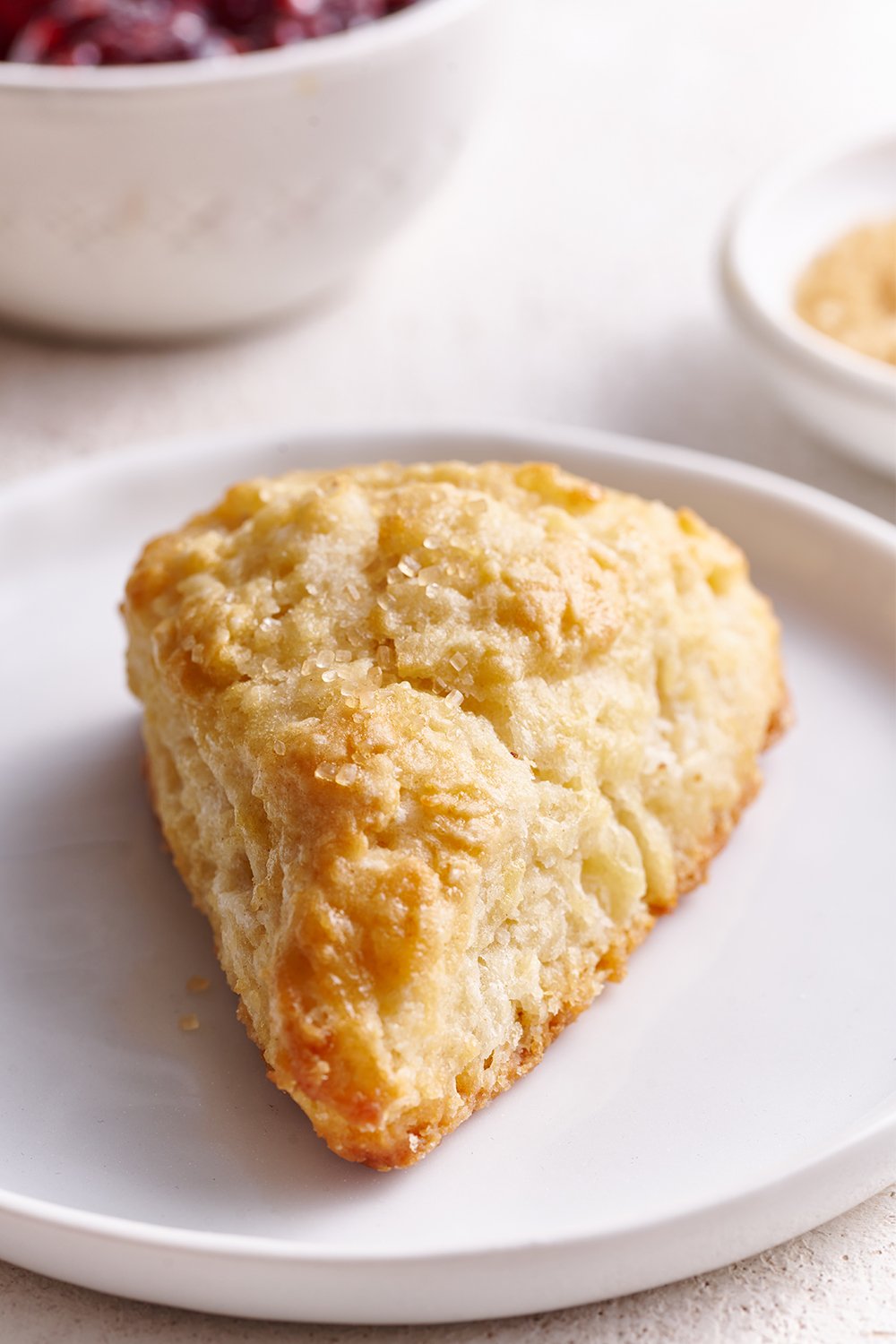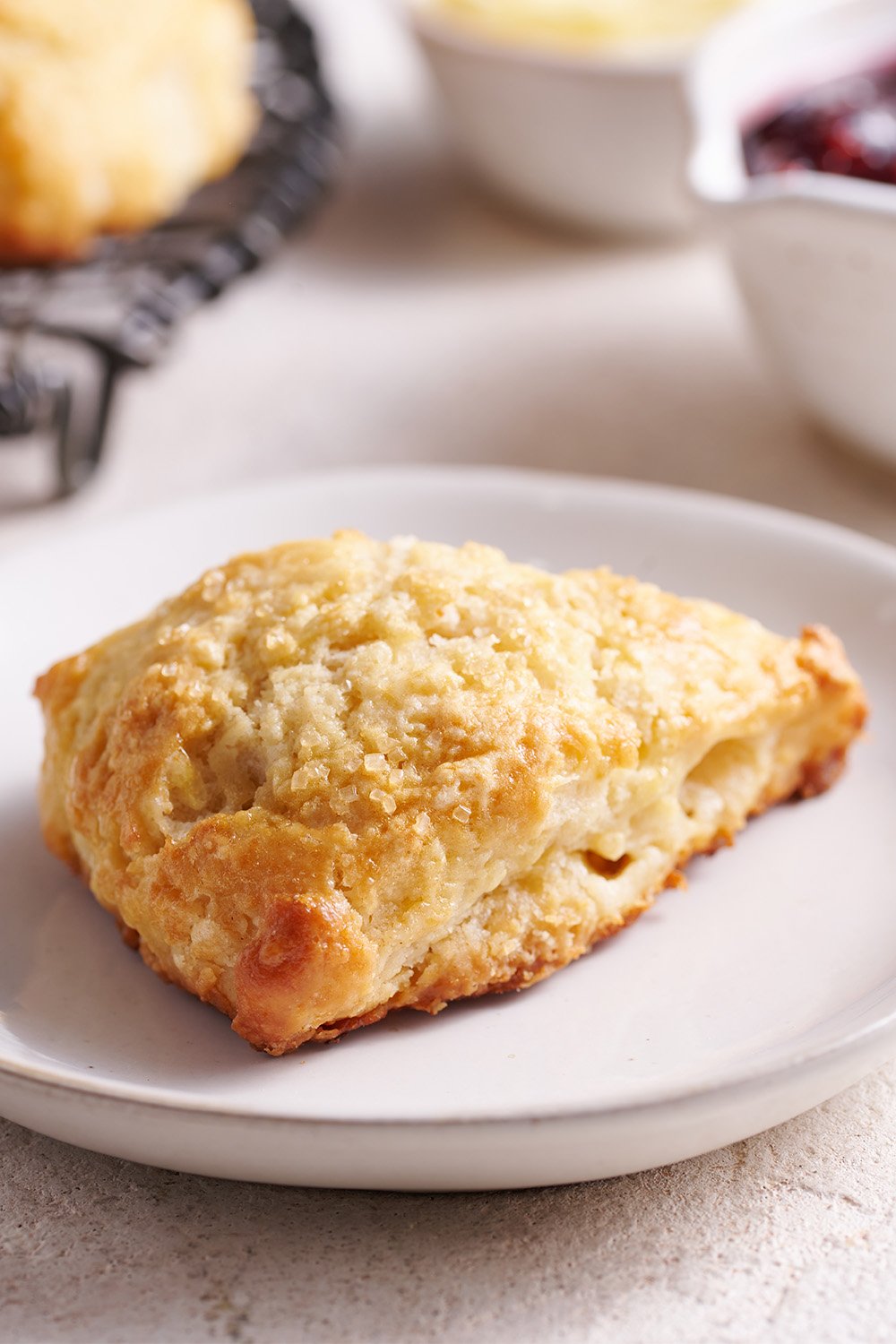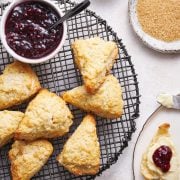Tessa’s Recipe Rundown
Taste: The plain scones themselves are ultra buttery with a hint of sweet tanginess. Customization & flavor options are endless!
Texture: Extremely tender, flaky, light, and golden brown on top. Every bite is heaven!
Ease: Super easy. Less than 40 minutes from start to finish, plus you can make them ahead of time.
Pros: This is the perfect recipe to have in your back pocket for any special breakfast or brunch.
Cons: None!
Would I make this again? Absolutely, this is a go-to scone recipe!
This post may contain affiliate links. Read our disclosure policy.
I never used to understand the obsession and appeal of scones. Not until I took a bite of a truly great one.
Many scones are bland and dense. Who wants that?

It wasn’t until I perfected my own recipe that I realized how delightful scones can be. They’re sturdier and heartier than biscuits because they contain eggs and more sugar.
What I love most about them (besides all. the. BUTTER.) is that they belong on pretty much any breakfast or brunch table.

You can dress them up by adding nuts, citrus zest, or chocolate chips. Or simply serve them plain alongside some local jam or homemade flavored butter. Or clotted cream, though this is more of an American scone recipe than British.
Any way you serve these, they’re bound to be perfect if you follow my tips below!


Sprinkle of Science
How to Make Scones
Get Flaky Scones with COLD Butter
- Butter must be COLD from the very start to when the dough enters the oven.
- The cold butter melts upon entering the oven and the water content in butter evaporates in steam.
- As the steam escapes, it bursts up and creates that beautiful tall, flaky, fluffy texture.
- I like to cube then freeze my butter before assembling the dough.
- I also always prefer to use unsalted butter for baking. You can find out why here: Salted vs. Unsalted Butter.
Why is Buttermilk Used in Scones?
This is absolutely the preferred liquid for scones. It will result in tender, taller scones because of how its acidity reacts with the baking powder and tenderizes the dough overall. It also adds a lovely tang to create more depth of flavor.
What if I Don’t Have Buttermilk? Can I Substitute and Still Make Scones?
I would NOT substitute buttermilk with a DIY alternative. If you aren’t able to use buttermilk, you can also use keffir or alternatively, heavy cream. You can learn more about the science of buttermilk here.
Tips for How to Make Scone Dough:
- Whatever you do, do not overmix the flour mixture or dough or allow it to get too warm. This will result in flatter, tougher, and less flaky scones.
- My absolute favorite tool for making biscuits or scone dough quickly and easily by hand (so I don’t have to lug out my food processor) is this OXO bladed pastry blender.
- Use a marble pastry board to help keep the dough cool. If at any point you notice the butter become greasy and melty, pop the dough into the freezer for 10 to 15 minutes before proceeding.
- You can also pop the baking sheet of shaped unbaked scones in the fridge or freezer while the oven preheats, to ensure the butter remains nice and cold.
How to Make Tall, Flaky Scones BONUS tip:
We’re stealing a trick from croissant baking that I use in my Best Ever Pie Crust recipe! A little bit of “lamination” gets the scones to shoot up sky-high with tons of flaky layers. Don’t worry, it sounds more complicated than it actually is. If this seems like way too much work, just skip this step. You’ll still have tasty scones! Check out my How to Make Tall Scones & Biscuits article for more tips.

How to Laminate Your Scone Dough:
- If adding any mix-ins, fold into dough prior to step 2.
- Turn the craggly mass of dough out onto your work surface.
- Shape it into a rectangle.
- Fold the rectangle horizontally in thirds, like you’re folding a piece of paper to go into an envelope.
- Flatten it out into a rectangle again.
- Now fold it in thirds once more, but going the opposite direction. This will also help you to gently ‘knead’ the dough so it comes together into a more cohesive disk without overmixing it. Overmixing leads to rubbery and tough scones and biscuits.
Try to shape half your scone dough using this trick and half without to compare the difference. You’ll be surprised!
I actually demonstrated this during a live Zoom class recently Take a look at Benjamin’s laminated vs. un-laminated scone:

How to Make Scones Ahead of Time:
The shaped unbaked scones can be covered and refrigerated overnight. Bake from the fridge as the recipe directs.
How to Freeze Scones:
Place in an airtight container and freeze for up to 1 month. If baking from frozen, add about 2 minutes to the baking time.
Scone Flavor Variations:
Feel free to get creative with your scone flavorings! Listed below are some ideas with specific ingredient additions. But you can add in about 3/4 cup of dried fruit, chocolate chips, nuts, etc., to the dough. If using fruit, dried fruit or frozen berries such as raspberries work best!
- Cranberry Orange
- Pumpkin
- Blueberry
- Chocolate Chip – Tastes like scones and chocolate chip cookies had a baby!
- Lemon Poppy Seed: Add 3 tablespoons poppy seeds + 2 tablespoons grated lemon zest to the dough.
- Cinnamon Sugar: Mix 3 tablespoons granulated sugar with 1/2 teaspoon ground cinnamon and sprinkle on the egg-coated unbaked scones.
How to Make A Glaze for Scones:
Glaze Ingredients:
- 1 1/2 cups (188 grams) powdered sugar
- 2 tablespoons water, milk, or citrus juice
- 2 tablespoons unsalted butter, melted
- 2 teaspoons vanilla extract, or other extract
- Citrus zest, to taste, if desired
Directions:
Whisk all glaze ingredients together until thick but still pourable. Spread over cooled scones and let stand until set.
More Recipes You’ll Love:
- Shallot, Jalapeno, and Cheddar Scones
- Red Lobster Cheesy Garlic Biscuits
- Quiche Lorraine
- Ultimate Muffin Recipe (customizable!)
- Chocolate Chip Scones

Become a Baking Genius!
Sign up for our free email newsletter for NEW recipes & baking science secrets.

Classic Scones
Ingredients
- 3 cups (381 grams) all-purpose flour
- 1/3 cup (66 grams) granulated sugar
- 1 teaspoon fine sea salt
- 1 tablespoon baking powder
- 1/2 teaspoon baking soda
- 1 1/2 sticks (170 grams) unsalted butter, cold and cubed
- 1 cup (237 grams) buttermilk
- 2 large eggs, divided
- 1 teaspoon vanilla extract
- Coarse sugar
Instructions
- Adjust the oven rack to the center position and preheat to 400°F. Line two baking pans with parchment paper.
- In a large bowl, combine the flour, sugar, salt, baking powder and baking soda.
- Add the butter and cut with a pastry cutter or a fork until the butter is the size of large peas.
- In a separate bowl, whisk together the buttermilk, 1 egg, and vanilla extract.
- Make a well in the middle and add the liquid mixture. Mix until just combined. Don't over mix. If adding in dried fruit, nuts, chocolate, or other flavorings, do so now.
- Transfer the dough to a floured surface. *Optional Step: See Recipe Notes for lamination instructions.
- Divide into 2 equal parts. Lightly knead each into 3/4-inch thick, 6-inch diameter rounds. Cut each round into 8 wedges and place on your prepared baking pans. Space them out about 2 inches apart.
MAKE AHEAD
- At this point the unbaked scones can be refrigerated overnight, or sealed and frozen for up to 1 month. If baking from frozen, add about 2 minutes to the baking time.
- In a small bowl, combine the remaining egg with 1 teaspoon water. Brush over the scones. Sprinkle with the coarse sugar.
- Bake for 12 to 15 minutes or until lightly browned. The scones are best served warm, or within a few hours of baking.
Recipe Notes
This recipe was originally published in May 2017 and was updated in 2023 with new photos and even more baking tips. Photos by Joanie Simon.



































Hi Tessa,
Hadn’t tried scones till today since we don’t get it in this part of the globe.. don’t know how it tastes but your recipe was amazing it came out so good. It was so flaky buttery and oh so good.. tried the lamination method and added dried cranberries.. my kids loved it.. will defntly try other flavor variations as well.
Thank you from Nepal🇳🇵
It says two eggs divided then the recipe says one egg. Where is the other egg used? Why has no one commented on this? Just got halfway through the dang recipe and dont know what to do.
Hi Cam! See step #9, the remaining egg is part of the egg wash 🙂 Enjoy your scones!
Hi, can we use the same amount of cake flour instead of all purpose flour?
Hi Nuha! The protein content in cake flour is much lower than all-purpose flour, which would result in a completely different taste and texture of scones. I wouldn’t recommend substituting. You can learn more about cake flour here. Hope that helps!
These were delicious. I’ve tried many recipes and these are by far the best ones I’ve made. I didn’t have white sugar but light brown sugar worked great in a pinch. Thanks for sharing, this recipe is going into my folder.
These are very good and fluffy (using your lamination method).
I make a double batch and froze one before baking. You note that the baking time is slightly longer, but do they need to defrost first? Thanks for the great recipe!
Hi Jan! I am so glad you enjoyed this scone recipe! You can either bake your scones from frozen by adding approximately an extra 2 minutes to the bake time, or you can defrost them in the refrigerator overnight, then bake them as the recipe instructs. Either way will work just fine! I hope this helps! Happy baking 🙂
The perfect scones, well let me say, they truly are. I did everything you suggested in all notes etc., because it made sense. I’ve baked scones before and they are just eh’, but these are fantastic! I made lavender scones this time around. Cooking is a passion and I am getting back into the baking part of things. Looking forward to trying/reading more of you have to offer. Thank you!!
I had my first scone 42 years ago in Scotland and that has been my goal to aim for. American scones tend to be too cake-like, whereas traditional scones are denser and not fluffy at all. Since my scones don’t have an egg in it and that’s not traditional, I suspect that the fluffiness is due to the addition of the egg. That said, I think my daughter-in-law will prefer these because they are more what she thinks scones should taste like after Starbucks.
I’m currently in my scone era, lol. After trying MANY recipes, I was lead to this one from a FB group suggestion. This recipe resulted in the scone of my dreams – perfectly flakey, tender & just sweet enough. (I used European butter & the lamination method). Can’t wait to try different flavor combinations.
Hi Tessa! I have been trying a different scone recipe for years! About 50% of the time they turn out, the other 50% they spread like crazy and burn!! I always use cold butter and pop them into the fridge before baking for least 15 minutes. ANYWAYS. i’m definitely excited to try your method. I’m wondering if you have a video including the lamination step?
Hi Jessica! The lamination step is shown in the video for these Blueberry Scones here (the video is located at the bottom of the recipe card). We can’t wait to hear what you think of these scones! Happy baking!
Is it possible to add strawberries to the dough or is there too much liquid from the berries?
Hi Lynne! We haven’t tried that, but as long as your strawberries are either fresh or still totally frozen, it should be okay. Let us know if you give that a try 🙂
Hi Lynne! I just read a great article on the King Arthur website about adding berries to scone dough. It suggested a couple of methods – the first is to lightly macerate the berries, drain the liquid off & then add the fruit to the dough. (Use the liquid to make a glaze). The second is roasting the fruit & then add to the dough. I have rhubarb-strawberry scones in mind & think I’m going to try the roasting method. Hope this helps!
Hi Deneen! Thanks for the tip! My alternative was to use dried strawberries but I’ll use the fresh first and see how they turn out.
I want to add ham, can I use the recipe with the sugar?
Hi Nancy! I would recommend skipping the sugar, as that might be a little too sweet for a savory scone. Alternatively, you could use our Shallot, Jalapeño, Goat Cheese & Honey Scones recipe here, and simply omit the shallot, jalapeno, cheese, honey, and spices, if preferred, and use ham (or ham and cheese!) instead. This will give you a better base for a savory scone. Let us know how it goes! Happy baking 🙂
Excellent advice. One can also substitute the buttermilk with double cream plain yoghurt. But buttermilk is the best!